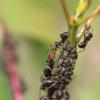Ttldr: oday I was able to breed (I think) Stigmatomma pallipes in captivity. Several pairings were observed (Though lasting less than 20 seconds each).
(Apologies for poor-quality pictures)
Started off with a male or two buzzing out in the outworld. I keep the colonies in a setup with hydrostone flooring and multiple containers with hydrostone chambers inside the nest. It was really amusing to observe the males inside the nests start getting very agitated and attempting to mate with even other males in the colony. I saw a few females running around in the outworld as well.
I took the setup outside, and once exposed to the sunlight activity seems to have increased tenfold. Part of this was the colonies moving everything into parts of the nests hidden from the light, another part was the males starting to really fly around in the outworld. I observed the first pairing within a minute of going out. The male was very clearly attached to the female, but they separated 10-15 seconds later, so I have no idea if anyone actually was fertilized.
Interestingly, the males seem to have only the instinct of going up. Multiple males were buzzing inside of nests annd were unable to figure out that the entrance/exits was below them.
I opened some of these nests, males flew out, more pairings occurred, all less than 20 seconds. In total, I observed 5 pairings over the course of an hour. However, I confess I wasn't paying attention the whole time. I was able to get most of what I described in pictures. They will be updated within the day.
Setup

Entrance/Exit Holes

What I think is a calling female. Interestingly, some of the dealates seem to have been calling as well

Male posing on top of the nest pre-takeoff

Pairing

Edited by Canadian anter, August 19 2020 - 11:39 AM.















